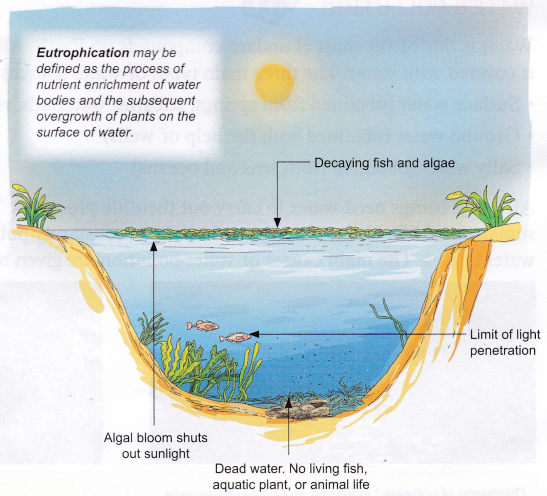Selina Concise Biology Class 10 ICSE Solutions Pollution- A Rising Environmental Problems
APlusTopper.com provides step by step solutions for Selina Concise ICSE Solutions for Class 10 Biology Chapter 15 Pollution A Rising Environmental Problems. You can download the Selina Concise Biology ICSE Solutions for Class 10 with Free PDF download option. Selina Publishers Concise Biology for Class 10 ICSE Solutions all questions are solved and explained by expert teachers as per ICSE board guidelines.
Download Formulae Handbook For ICSE Class 9 and 10
ICSE SolutionsSelina ICSE Solutions
Selina ICSE Solutions for Class 10 Biology Chapter 15 Pollution – A Rising Environmental Problems
Exercise 1
Solution A.1.
(d) The dust raised during road-cleaning
Solution A.2.
(b) Disposing of corpses in rivers
Solution A.3.
(b) Ozone
Solution B.1.
(i) SO2
(ii) Bromochlorodifluoromethane and chlorofluoromethane
(iii) Mercury
Solution B.2.
Column I | Column II (Answers) |
| (i) Chlorofluocarbons (CFCs) (ii) Flyash (iii) Cow dung (iv) CO2 and methane (v) Sulphur dioxide (vi) Iodine – 131 | (f) Ozone depletion (e) Industrial Waste (b) Biodegradable (a) Global Warming (d) Acid Rain (c) Nuclear Radiation Pollutant |
Solution B.3.
(i) vehicular air
(ii) X-ray
(iii) hot
(iv) domestic activities
Solution C.1.
(i) Rivers contaminated with sewage:
- A number of waterborne diseases are produced by the pathogens present in polluted water, affecting humans as well as animals.
- The flora and fauna of rivers, sea and oceans is adversely affected.
(ii) Too much gaseous exhausts containing CO2 and SO2:
- The high concentration of CO2 in atmosphere has been the main component of the green house effect that has caused global warming i.e. the rise of atmospheric temperature in recent years. Global warming causes melting of snow caps rise in sea levels.
- SO2 is poisonous and irritates the respiratory system of animals and humans. A continuous exposure to SO2 has been reported to damage the lungs and increase the rate of mortality.
- SO2 is also responsible for acid rain
(iii) Pesticides such as DDT used in agriculture:
- Pesticides kill soil microbes which are responsible to recycle the nutrients in the soil.
- Pesticides can enter the food chain and affect the health of humans as well as animals. It can cause damage to the lungs and central nervous system, failures of reproductive organs and dysfunctions of the immune system, endocrine system, and exocrine system, as well as potential cancer risks and birth defects.
(iv) Prolonged noise such as the one produced by crackers throughout night:
- Prolonged exposure to the high decibel noise damages ear drums and can bring permanent hearing impairment.
- Noise pollution can lead to high blood pressure (hypertension), constant headache, lack of concentration.
Solution C.2.
Three major constituents of sewage:
- Kitchen wastes
- Sanitary waste
- Waste from agricultural lands
Solution C.3.
- The common sources of oil spills are: The overturned oil tankers, offshore oil mining and Oil Refineries.
- The sea birds and sea animals sometimes get thick, greasy coating on their bodies due to oil spills.
- Sea birds may ingest their oil coated. This may irritate their digestive system, may damage liver and kidney.
- Oil spills lead to the death of sea birds as well as sea animals.
Solution C.4.
Measures to minimise noise pollution:
- Use of loud speakers should be banned.
- Airports should be located away from the residential area.
Solution D.1.
- Industrial Waste:
Large number of industries produces waste water which contains various types of chemical pollutants. Such wastes are commonly discharged into the rivers. These chemicals cause irritation to the body systems of fish. - Thermal Pollution:
Many industries such as thermal power plants, oil refineries, nuclear plants use water for cooling their machinery. This hot waste water may be 8-10oC warmer than the intake water. This hot water is released into the nearby streams, rivers or the sea and causes warming. The sudden fluctuation in the temperature of water kills the fishes and harms the plant life growing in it.
Solution D.2.
(i) Noise Pollution
(ii) Industrial machines, workshops, trains, loud conversation, loudspeakers, etc.
(iii) Effects of noise pollution:
- It lowers efficiency of work.
- It disturbs sleep and leads to nervous irritability.
More Resources for Selina Concise Class 10 ICSE Solutions


